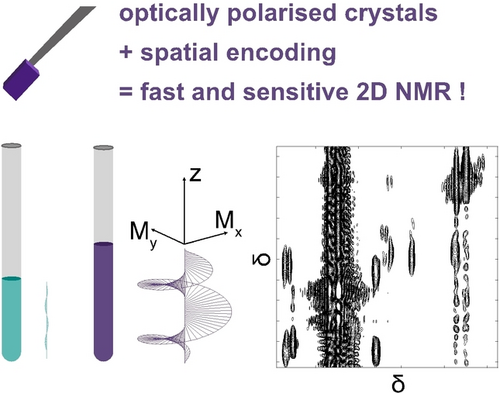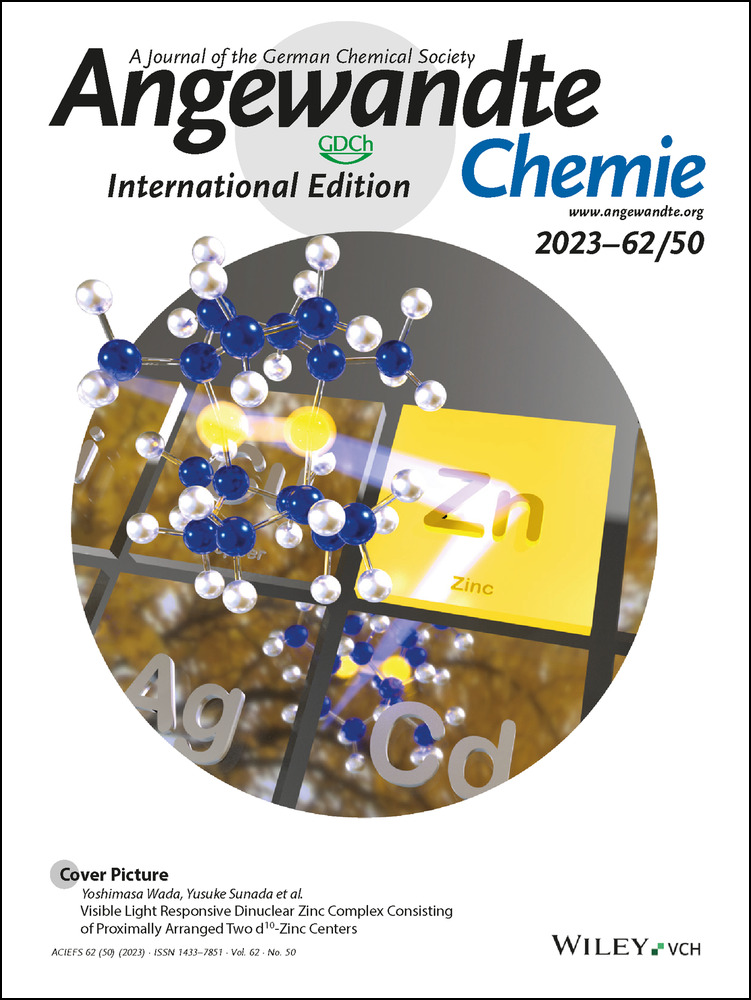Solution-State 2D NMR Spectroscopy of Mixtures HyperpolarizedUsing Optically Polarized Crystals
Graphical Abstract
HYPNOESYS (Hyperpolarized NOE System) has recently emerged as a promising approach to enhance the sensitivity of NMR spectroscopy in the solution state. We show that 2D NMR spectra can be obtained from HYPNOESYS-polarized samples, using single-scan acquisition methods, paving the way to a sensitive, information-rich and affordable analytical method.
Abstract
The HYPNOESYS method (Hyperpolarized NOE System), which relies on the dissolution of optically polarized crystals, has recently emerged as a promising approach to enhance the sensitivity of NMR spectroscopy in the solution state. However, HYPNOESYS is a single-shot method that is not generally compatible with multidimensional NMR. Here we show that 2D NMR spectra can be obtained from HYPNOESYS-polarized samples, using single-scan acquisition methods. The approach is illustrated with a mixture of terpene molecules and a benchtop NMR spectrometer, paving the way to a sensitive, information-rich and affordable analytical method.
Mixtures of molecules in solution are found everywhere and include, e.g., biofluids, extracts, or the outcome of chemical syntheses. Their analysis is important for application areas ranging from organic chemistry to biomedicine, and requires sensitive methods with chemical resolution to determine their composition. Nuclear magnetic resonance (NMR) spectroscopy is a powerful tool for the direct, separation-free analysis of mixtures, which provides structural information that is key to identify compounds in solution, as well as quantitative measurements of concentrations.1-3 The sensitivity of NMR, however, is a major limitation for mixture analysis, with limits of detection that are less favourable than for other analytical methods. The modest sensitivity of NMR spectroscopy results from the small population differences between spin energy levels at thermal equilibrium, measured as the polarization level, which is ±1 for fully polarized spins, but only 0.004 % (0.0006 %) for proton spins in a magnetic field of 11.7 T (1.9 T) at 298 K. An array of hyperpolarization methods has been developed to increase polarization levels beyond their thermal equilibrium values.4 For mixtures of molecules in solutions, dissolution dynamic nuclear polarization (D-DNP) and parahydrogen-induced polarization (PHIP) have found the most success.5-16 However, the former requires highly expensive and specialized equipment, while the latter is limited to specific classes of compounds.
HYPNOESYS (Hyperpolarized NOE System) is a novel and promising method to polarize nuclear spins of molecules in solution.17 HYPNOESYS relies on pentacene-doped naphthalene crystals, in which nuclear spins are polarized to levels above 20 %, by optical polarization of the pentacene defect followed by dynamic nuclear polarization.18 The HYPNOESYS experiment then consists of crushing the crystals and dissolving them in an organic solution that contains the substrates of interest, before injection into an NMR tube for detection. Intermolecular polarization transfer in solution then results in enhanced polarization levels for the analytes. Importantly, the naphthalene crystals, once polarized, can be stored for extended durations,19 opening the possibility to dissociate their production from their use, thus lowering the cost and increasing the accessibility of the method. The HYPNOESYS concept was demonstrated for small molecules, using a benchtop NMR spectrometer.17 Benchtop NMR spectrometers introduce portability and cost-reduction to NMR spectroscopy, albeit at the cost of sensitivity and more overlap in the 1D spectra even for simple compounds. 1H 1D spectra were acquired with sensitivity enhancement by factors of up to over 1000 at 1.9 T. These molecules, however, had simple 1H 1D spectra, without peak overlap, while all but the simplest mixture display some degree of peak overlap.
Two-dimensional experiments are highly useful, and often mandatory, for the NMR analysis of mixtures.2, 20 2D NMR provides increased signal dispersion, which helps to resolve signals that are overlapped in 1D spectra, as well as additional structural information that guides compound identification. The additional dispersion is particularly welcome on benchtop spectrometers.21-23 The HYPNOESYS approach, however, is a single-shot polarization method which, like D-DNP, is not generally compatible with conventional multi-scan methods for 2D NMR. The crushing and mixing process in HYPNOESYS is irreversible and cannot be repeated for the same solution, and once in solution, the naphthalene polarization decays irreversibly with a time constant of the order of 20 −25 s. Since most 2D experiments, including COSY (correlation spectroscopy) and TOCSY (total correlation spectroscopy) experiments, involve 90° excitation pulses that entirely deplete the longitudinal polarization, their implementation based on multiple consecutive scans is compromised. This is a limitation for mixture analysis and other applications.
Ultrafast (UF) 2D NMR makes it possible to acquire a complete 2D NMR data set in a single scan, by spatial parallelization of the indirect time dimension.24, 25 UF 2D NMR is ideally suited for the acquisition of 2D homonuclear correlation spectra from hyperpolarized substrates, as was demonstrated with D-DNP and several parahydrogen-based methods.10, 26-30 Importantly, while the use of UF 2D NMR for thermal equilibrium experiments comes with a sensitivity penalty compared to conventional 2D acquisitions, this consideration does not apply for single-shot hyperpolarization methods.31, 32
In this communication, we show that 2D 1H−1H correlation spectra can be acquired for a mixture of molecules that are hyperpolarized by HYPNOESYS. We first show that terpene molecules in a mixture, an important class of natural products that are extensively used in chemical synthesis, can be efficiently polarized by HYPNOESYS, with enhancements reaching over 200 on a 1.9 T benchtop spectrometer. We then show that, using UF 2D NMR, COSY spectra of the mixture are obtained in a single scan. These results open the path towards a broadly applicable, affordable and information-rich analytical method.
The scope and relevance of hyperpolarization methods for solution-state NMR spectroscopy is determined by the types of molecules and nuclei that can be polarized, as well as the polarization levels that can be achieved, and the quality of the enhanced spectrum. The HYPNOESYS method was reported only recently, and described with a small set of compounds.17 Figure 1a shows the hyperpolarized 1H 1D spectrum of a mixture of three terpenes, the structure of which is shown in Scheme 1. The solution was prepared by mixing and dissolving crushed crystals of polarized naphthalene with a solution of three analytes in deuterated acetone, then transferring the mixture to a benchtop NMR spectrometer operating at a 1H Larmor frequency of 80 MHz. The concentration before mixing the solution with the crystal is 85 mM for each of the terpenes. The spectrum was acquired 40 s after mixing, for intermolecular polarization transfer in solution (see Supporting Information for full experimental details). The spectrum of Figure 1a shows that the three molecules are efficiently polarized, with enhancements reaching up to 250 compared to the thermal equilibrium spectrum acquired on the same sample after thermalization. This result illustrates the fact that the intermolecular cross-relaxation on which the HYPNOESYS experiment relies should be applicable to a broad range of compounds, and not limited to specific chemical moieties. The spectrum also illustrates the fact that, even for simple mixtures, there is extensive overlap in 1H 1D spectra on benchtop NMR spectrometers.
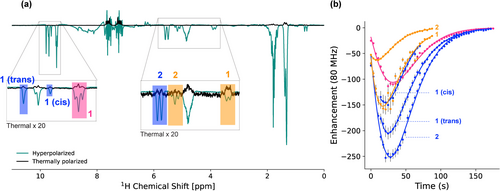
(a) 1D 1H NMR spectra of a mixture of three terpenes (citral, citronellal and geraniol), acquired using HYPNOESYS after a polarization transfer delay of 40 s (green), and after the spin magnetization has returned to its equilibrium value (black). The hyperpolarized spectrum was processed according to the procedure described in Figure S2. (b) Enhancement of selected signals in the mixture spectrum as a function of the delay after injection, calculated from a series of small-tip-angle 1D 1H spectra. The integration regions for each peak are shown in panel (a). The colors for the three molecules are as in Scheme. 1.
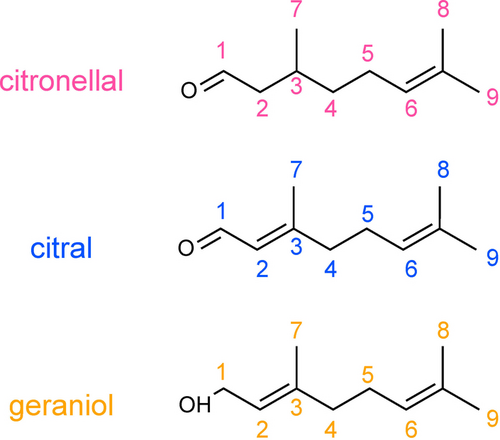
Structure of the three terpene molecules analyzed in this work.
The transfer of polarization from hyperpolarized naphthalene to the analytes in solution was monitored with a series of 1D spectra acquired with small-tip-angle excitation, and is shown in Figure 1b. These polarization transfer curves show that the rate of initial polarization transfer and the maximum enhancement are not uniform for all the protons in solution. Eichhorn et al. have shown that these quantities are a function of the intermolecular cross relaxation rate, as well as the longitudinal relaxation of the naphthalene protons and of the target protons.17 As a result, single-scan acquisition requires choosing a compromise value for the polarization transfer delay. Still, the polarization transfer curves are broad, because their long-term decay occurs on the timescale of the longest-relaxing protons (most often the naphthalene protons). A delay of 40 s thus provides a good compromise for the different molecules and moieties in the mixture, and was used for single-scan 2D experiments.
A 2D 1H−1H COSY spectrum acquired from the hyperpolarized terpene mixture is shown in Figure 2b. This spectrum was acquired in a single scan with the ultrafast 2D NMR pulse sequence shown in Figure 2a, and would not be possible to acquire with a different method. Cross peaks that are specific to each of the three compounds are clearly resolved, illustrating the increased signal dispersion of 2D NMR spectra. These results demonstrate the possibility to acquire 2D data for HYPNOESYS-hyperpolarized mixtures, a concept that can be extended to a number of other samples and pulse sequences.
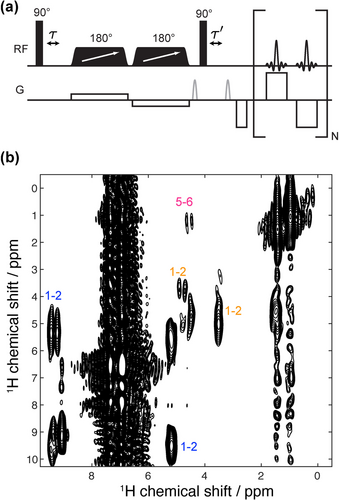
(a) Pulse sequence for ultrafast 2D correlation spectroscopy (UF 2D COSY). (b) UF 2D COSY spectrum of a mixture of three terpenes (citral, citronellal and geraniol) acquired using HYPNOESYS after a polarization transfer delay of 40 s. The delays after the 90° pulses were 20 ms. The colors for the three molecules are as in Scheme 1.
The results shown in Figure 2 involved a number of modifications to the initial implementation of the HYPNOESYS approach, and to the usual UF COSY pulse sequence. The first modification consisted of optimizing the injection process for HYPNOESYS, in order to minimize sample convection that is detrimental for UF 2D NMR. Specifically, the injection pressure was reduced to 250 mbar, and the injection time was extended to 16 s, with no significant effect on the polarization levels. The second modification consisted of introducing a delay between each of the 90° pulse and the subsequent gradient pulse in the UF COSY pulse sequence (noted and in Figure 2a), in order to let the very large naphthalene magnetization partly return to the longitudinal axis via the radiation-damping effect.33, 34 In the absence of these delays, the naphthalene magnetization is dephased and radiation-damping effects are attenuated. While this may in other circumstances be a route towards suppressing the naphthalene signal, the gradient-based acquisition employed in UF 2D NMR pulse sequences refocus the naphthalene magnetization, resulting in very large signals that significantly reduce the spectrum quality. This is illustrated in Figure S3, with experiments carried out for a solution of propargyl acetate polarized with HYPNOESYS. The optimized implementation of the UF COSY pulse sequence was found to give signal enhancements for this solution that are comparable to the ones measured in the corresponding 1H 1D spectrum, indicating that there is no detrimental interference between the spatially parallelized NMR experiment and sample injection - the SNR of thermal-equilibrium UF COSY spectra on the terpene mixture are not sufficient to calculate enhancements. Also, the signal-to-noise ratio obtained from these≈100 mM samples suggests that detection at low-millimolar concentrations should be possible.
Differences in relative peak volumes can be noted between the UF COSY spectrum acquired for the hyperpolarized sample, and reference COSY spectra acquired on concentrated samples at thermal equilibrium (shown in the SI). These differences are not only due to site-specific enhancement factors, but also to the modulation of peak volumes due to J coupling that occurs with constant-time UF 2D NMR pulse sequence such as the one shown in Figure 2a.35 The total modulation time can be adjusted for optimized sensitivity, by changing the delay just after the first excitation pulse, and in this case 20 ms was found to provide a good compromise.
The quality of the UF 2D NMR spectra obtained with HYPNOESYS would clearly be improved if the signal of naphthalene protons were suppressed, and developments in this direction using, e.g., selective pulses,30 will be beneficial. The use of selective pulses would also open the intriguing possibility to acquire another 2D spectrum after a suitable polarization transfer delay. In the present case, even though the naphthalene magnetization is partly returned to the longitudinal axis by radiation damping, we found that subsequent UF COSY experiments, while possible, displayed modest enhancements. Another important question for future investigations concerns the possibility to perform quantitative measurements with hyperpolarized UF NMR, which will build on developments for quantitative 2D experiments at thermal equilibrium.20
In summary, we have shown that 2D spectra can be acquired for mixtures that are hyperpolarized using optically polarized crystals. This addresses one of the main limitations of the HYPNOESYS method, and increases its relevance by unlocking otherwise inaccessible spectral information. We trust that these developments open the way to a number of applications to the analysis of mixtures and other fields
Supporting Information
Supporting Information is available.
Acknowledgments
This work has received funding from the European Research Council (ERC) under the European Union's Horizon 2020 research and innovation program (grant agreements no 801774/DINAMIX and 814747/SUMMIT) the Region Pays de la Loire (Connect Talent HP NMR). The author also acknowledges the French National Infrastructure for Metabolomics and Fluxomics MetaboHUB-ANR-11-INBS-0010 (www.metabohub.fr) and the Corsaire metabolomics core facility (Biogenouest).
Conflict of interest
Anna J. Parker, Mohammad Usman Qureshi, Jakob M. Steiner, John W. Blanchard, Jochen Scheuer, Nikolas Tomek, Stephan Knecht, Felix Josten, Christoph Mueller, Ilai Schwartz, and Tim R. Eichhorn are/were employees of NVision Imaging Technologies GmbH (NVision).
Open Research
Data Availability Statement
The data that support the findings of this study are available from the corresponding author upon reasonable request.



